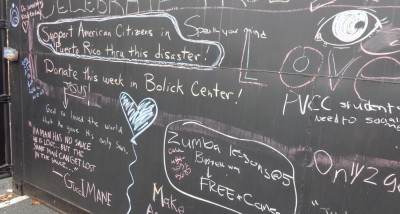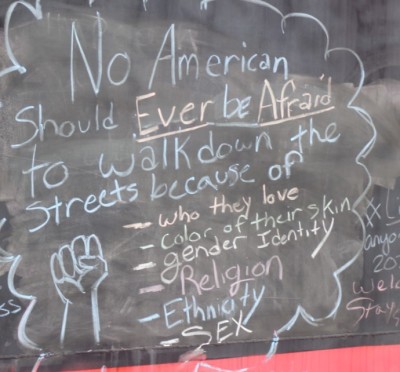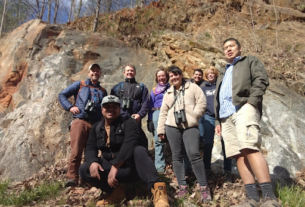
Free Speech on College Campuses
Charles Stish, assistant editor

Monday, Oct. 16 was the beginning of PVCC’s Free Speech Week, a time when students and faculty could celebrate their First Amendment rights via the Thomas Jefferson Center for Protection of Free Expression’s mobile free speech monument. On this monument, people could express themselves through words or imagery without fear of being openly ridiculed or censored. Yet, as the First Amendment is a subject of modern dispute, PVCC held a seminar in Auditorium (M229) on Oct.16 to establish and discuss the limits, protections, and responsibilities of free speech.
Going from 12-1 p.m., the seminar was hosted by PVCC’s Assistant Professor of Political Science Connie Jorgensen. For this event, Jorgensen invited Clay Hansen, the executive director of the Thomas Jefferson Center for Protection of Free Expression, to be the main speaker and presenter for this discussion.
Hansen began with, “So what are we talking about when we talk about free speech on campus? It’s actually two distinct concepts. On the one hand, we have the speech rights of the academic faculty and to a lesser extent those of the school itself. This is what we typically think of in terms of academic freedom. On the other hand, we have the rights of the students and student speech is primarily an issue of expressive freedom. Because the vast majority of college students are adults, we would expect the speech rights enjoyed by students merely parallel the those of the public at large but as we can see that’s not always the case.”
Hansen said that despite their differences, the two concepts are both being censored in censored in college communities.
“Among the inventions of modern life, few have proven more important for the promotion of freedom and progress than a university that is organized around the search for knowledge based on free inquiry and reasoned debate,” said Hansen.
Hasen said the first example of a Western academic institution transitioning from one of censorship and strict indoctrination to one of free expression and academic argumentation of dissenting opinions was in 1663 with the British Royal Society’s motto: “Nullius in verba,” which means “Take nobody’s word for it.”
Hansen said this change slowly influenced Western academics into believing in the same philosophy. One of these academics was Thomas Jefferson who said this of the University of Virginia when constructing it: “This institution will be based on the illimitable freedom of the human mind. For here we are not afraid to follow truth wherever it may lead, nor to tolerate any error so long as reason is left free to combat it.”Hansen stated by the 20th century, most colleges and universities gave control of free speech on campuses to the individual faculty members and away from supervising collegial boards.
Some mentioned examples of this mentality includes the University of Chicago’s 1902 statement on free speech, the Association of American University Professors (AAUP), and the Berkely University free speech movement. Chief Justice Warren stated in a court case on the subject, “The essentiality of freedom in the community of American universities is almost self-evident. Scholarship cannot flourish in an atmosphere of suspicion and distrust. Teachers and students must always remain free to inquire, to study and to evaluate, and to gain new maturity and understanding otherwise our civilization will stagnate and die.”
Hansen suggested thinking, as backed by observations in the book Free Speech on Campus, of a college campus being divided into two free speech sections. One is smaller and dedicated to professionalism and upholding responsible and civil conduct, but the other is larger and more casual and is not restricted by the other section’s parameters. He also noted the two sections should not clash or interject into one another, meaning that depending on the section you are in, act and behave accordingly and responsibly.
Hansen said, “The fact remains that there is an undeniable temptation among many of today’s campus activists to excommunicate those who, on their own time, express opinions and views others in the community disapprove of.” He gave a statistic from a 2015 poll that showed 72 percent of students supported disciplinary action for students and faculty who express racist, sexist, homophobic, and other offensive thoughts.

Hansen believes as this generation is taught at a young age that bullying and hate is wrong and unacceptable, they are predisposed to protecting those who they believe are being prejudiced against, making this moral imperative to establish safe spaces or turn their college into a safe space. Hansen stated displeasure at this idea because it reminds him of the older form of Western colleges before 1663, where dissention and debate of opinions were prohibited.
Hansen also stated hate speech is a protected form of speech under the rights of the First Amendment and it is unconstitutional to censor or ban it, yet physical violence is not protected.
Hansen said, “Now it may sound like I’m placing the blame of our current problems entirely on the shoulders of these ‘speech hating student activists’ but, in reality, I think there is plenty of blame to go around.” Hansen said he believes most schools do an inadequate job for setting viable examples of responses to dealing with offensive speech, but understands why for he thinks these schools and their administrators will be condemned no matter if they decide to allow or censor certain forms of free speech.
“From top to bottom, college communities are undeniably less willing to hear, let alone actually listen to, certain ideas. Until students, faculty, and administrators learn to appreciate the necessity of allowing unpopular, and even offensive ideas, free speech will remain under fire,” said Hansen.
After Hansen’s presentation the Q&A section began. One student asked about the events of Aug. 12 and its following political aftermath. Another student asked about the increase of political violence on college campuses, using anti-fascist (a far-left group that strongly opposes Nazi ideals) actions at the Berkeley rally on Aug. 28 as an example. Hansen answered these questions confidently and eloquently to clarify any misunderstandings, confusions, or inquiries the students had.
Hansen concluded, “It might be good at this time to remind everyone that you should never formulate your opinions on free speech and the value of free expression based on today’s bad guys, regardless of which side you’re on. Don’t look around at who’s fighting who today and say, ‘Free speech is good because I agree with this,’ or ‘Free speech is bad because I’m being silenced.’ Because the one thing you can be certain of is your time will come and it [approved general consensus] will switch.”






